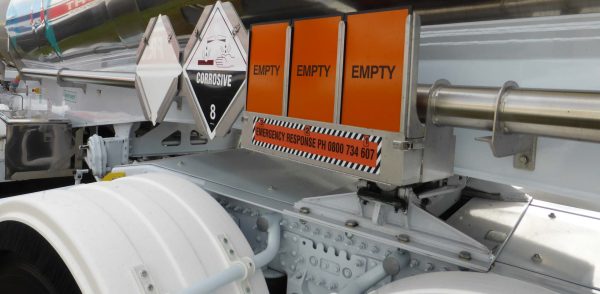Corrosive substances pose unique challenges for transport drivers. From powerful acids that can eat through metal to strong alkalis that cause severe burns, these Class 8 materials demand careful handling and thorough preparation. As a driver responsible for transporting corrosives, understanding their properties and required safety measures is essential for both your protection and public safety.

Understanding Corrosive Materials
Corrosive substances come in both liquid and solid forms, with the power to damage or destroy living tissue and other materials through chemical action. Think of these substances like sandpaper on steroids—while sandpaper works through physical abrasion, corrosives break down materials at a molecular level through chemical reactions. Common examples include sulphuric acid used in batteries, hydrochloric acid for industrial cleaning, and sodium hydroxide (caustic soda) used in manufacturing.
Pre-Transport Preparations
Before setting out with any corrosive load, verify that your vehicle meets ADR requirements and carries the correct placarding. The distinctive Class 8 hazard diamond, showing a test tube dripping liquid onto a metal bar and a hand, must be clearly visible. For tanks and bulk containers, you’ll need orange plates displaying the appropriate hazard identification number (HIN) and UN number.
Personal Protective Equipment
Your PPE kit is your last line of defence against corrosive materials. Always carry and maintain:
- Chemical-resistant gloves
- Full face shield or goggles
- Chemical-resistant boots
- Emergency eyewash bottle
- Protective overalls
Remember that corrosive vapours can be as dangerous as the liquid or solid form. In some cases, you may need respiratory protective equipment (RPE), especially during loading and unloading operations.
Loading and Transport Considerations
Proper segregation is vital when transporting corrosion. These substances must be kept separate from foodstuffs and animal feed. Additionally, acids and alkalis should never be transported together, as their reaction could be violent if containment fails.
Pay particular attention to the weather when transporting corrosives. Many of these substances react more aggressively at higher temperatures, and some may require temperature control during transport. Your vehicle’s temperature monitoring systems should be checked regularly throughout the journey.
Emergency Response
If the worst happens and you experience a spill or leak, your first priority is personal safety. Move upwind of any vapours and contact emergency services immediately. Keep other people away from the area and use your spill control equipment if it’s safe to do so. Remember that water isn’t always the answer—some corrosives react violently with water, potentially making the situation worse.
Documentation and Training
Always carry your dangerous goods transport document and instructions in writing. These documents contain vital information about the specific corrosive substances you’re carrying and emergency response procedures. Keep them readily accessible, not buried under other paperwork.
Conclusion
Transporting corrosive substances requires constant vigilance and respect for their destructive potential. By maintaining proper safety protocols and staying prepared for emergencies, you can help ensure these hazardous materials reach their destination safely. Remember, when it comes to corrosives, prevention is always better than cure—one small lapse in procedure could have serious consequences.
For the latest guidance on corrosive substance transport, always refer to the current ADR regulations and your company’s specific procedures. Your role as a driver is vital in maintaining the safe movement of these essential but dangerous materials across the UK’s roads.
